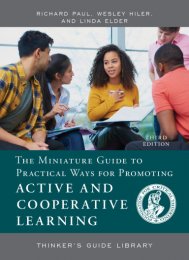The Miniature Guide to Practical Ways for Promoting Active and Cooperative Learning
Third Edition
Contact Info for Rowman & Littlefield:
- Toll-free: (800) 462-6420 ext. 3024
- Fax: (800) 338-4550
- Orders to orders@rowman.com
- Queries to customercare@rowman.com
This pocket guide lays out straightforward, powerful strategies teachers can implement to immediately get students actively engaged in thinking critically about what they are learning. As they adopt the critical thinking strategies in this guide, students become more responsible for their learning, along with their peers, under the guidance of the teacher.
As part of the Thinker’s Guide Library, this book advances the mission of the Foundation for Critical Thinking to promote fairminded critical societies through cultivating essential intellectual abilities and virtues across every field of study across the world.
Rowman & Littlefield Publishers / The Foundation for Critical Thinking
Pages: 16 • Trim: 4 3/4 x 5 1/2
978-0-944583-13-5 • Paperback • January 2006
978-1-5381-3390-3 • eBook • June 2019
Series: Thinker's Guide Library
$17.00
Additional Information About:
The Miniature Guide to Practical Ways for Promoting Active and Cooperative Learning
27 Practical Ways To Improve Instruction
Although bringing critical thinking into the classroom ultimately requires serious, long-term development, you don’t need to sweat and slave and thoroughly understand critical thinking to begin to make important changes in your teaching. Many simple, straightforward, yet powerful strategies can be implemented immediately. In this guide we offer a sampling of such suggestions. They are powerful and useful, because each is a way to get students actively engaged in thinking about what they are trying to learn. Each represents a shift of responsibility for learning from the teacher to the student. These strategies suggest ways to get your students to do the hard work of learning.
Many enable you to take advantage of what students already know and what they are able to figure out for themselves. Many involve students working together. All too often students get stuck, or don’t understand what they are supposed to do. Several students working together can correct each other’s misunderstandings and can make much more progress on tasks. When one student gets stuck, another might have just the right idea to move things along. This enables students to become responsible for more of their own learning. Over time, they begin to adopt the strategies they see their peers use successfully and learn to ask themselves critical questions raised by their peers.
Another advantage of the following suggestions is their wide applicability. Most can be fruitfully applied to any subject, any topic. Most can become standard practice - techniques you continually use. For some of these strategies, we provide examples geared to different content they might be used to teach.
At the heart of our approach is a realistic conception of what it takes for someone to learn something. In a sense, much instruction is unrealistic: "If I say it clearly, they should get it. If they give the right answer, they know it and understand it. If I show them what to do, ask them to do it, and they repeat my performance, they have learned the skill and it is theirs whenever they need it. If I tell them why something is true or is important and they nod their heads and repeat it back, they understand the truth or importance of what I have said.”
This is not necessarily so. Often students’ failure to do well, to apply what they have covered, to remember in the fall what they learned the previous spring, results from the above naive misconceptions about what learning requires. Above all, learning requires thinking, critical thinking. To learn, one must continually ask "What does this really mean? How do we know? If it is true, what else would be true?" At the heart of our approach is the conviction that, ultimately, learners must answer these questions for themselves in order to learn, to know, to truly understand. Answers you provide do not entirely sink in unless students’ minds are ready to take them in.
This Guide contains suggestions, or "teaching tactics", that provide ways to begin this process of enabling students to think their way through the material they are expected to learn, to learn how to use what they learn, and use the power of their own minds to "figure things out".
Contents include:
- During Lectures Ask the Class Questions to Arouse Curiosity
- Teach the Principles of Critical Thinking Along with the Subject Matter
- Put Students’ Names on Index Cards and Call on All Students, Not Just Volunteers
- Promote Independent Thinking and Careful Listening
- Speak Less so that Students Think More
- Be a Model
- Use Socratic Questioning
- Promote Collaboration
- Have Students Do Pre-writing
- Give Written Assignments that Require Independent Thought
- Have Students Evaluate Each Other’s Work
- Organize Debates
- Have Students Write Constructive Dialogues
- Have Students Explain their Current Assignment and its Purpose
- Have Students Document Their Progress
- Promote Self-Assessment
- Teach for Usefulness
